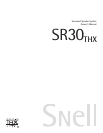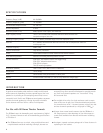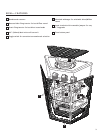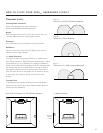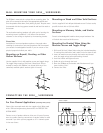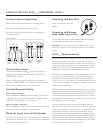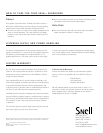
4
FEATURES OF THE
SR30
THX
SURROUND
Unique Cabinet Design
A sealed enclosure above and a unique matrix array below
project sound in three distinct polar patterns. The truss panel
bottom reduces the detrimental effects of standing waves
within the cabinet.
Speaker Elements
Three 1-inch aluminum-dome tweeters cover frequencies
above 3kHz. Two 3.5-inch (89mm) extended-range drivers are
responsible for frequencies between 400Hz and 3kHz. One
omnidirectional 6.5-inch (135mm) dual-voice coil bass unit
handles all frequencies from 60Hz to 400Hz.
Family of Sound
The SR30
THX
’s are tuned with a flat, optimized power response,
to match the spectral balance of Snell front speakers. The use of
common Snell driver units and careful optimization provide a
direct mode frequency response that is an excellent match with
Snell front speakers.
Hand-Tuned Crossover
The filter network is optimized to provide a smooth and flat
power response in diffuse mode. Each crossover is tuned by our
technicians to 0.5dB of the Master Reference, assuring pre-
dictable performance in your home. Furthermore, a sophisticated
switching network enables the SR30
THX
to perform in any
application.
Mounts to Walls
Our unique locking bracket keeps the SR30
THX
securely mounted
to walls. One person can install the SR30
THX
simply, securely,
and easily.
Connectors
Five-way gold-plated binding posts allow quick connection to
speaker cables and connections. Furthermore, removable jumpers
accommodate the use of SR30
THX
in 7.1 channel applications,
now or for future system upgrades.
HOW TO PLACE YOUR SR30
THX
SURROUNDS
Theory of Operation
Today, surround speakers are called upon to do one of two
disparate tasks. For some movies, you may want a surround to
create an all-enveloping diffuse field. Sound should arrive
at your two ears by bouncing numerous times off of all your
listening room walls.
Conversely, with multichannel music, you may want the musical
stage to widen beyond the front speakers by having a spread of
five near-identical speakers over a semicircular arc around you.
You may want movie effects to pan solidly off the screen and to
the sides. This demands the side speakers to be well matched to
your front speakers both in frequency balance and in their more
focused directional characteristics.
Until now, surround sound speaker designers had to choose
between satisfying one requirement or the other, or perhaps
choosing a middle-ground compromise. The SR30
THX
provides
a choice of surround sound modes, allowing performance to
be tailored to program material.
Placement
Although often mistakenly referred to as rear speakers, your
surround speakers should ideally be placed to the left and right
of the listening area. In the diffuse mode, internal switching
converts the radiation pattern of the super surround to a fore
and aft radiating dipole (see Figure 1A). This null will reduce the
amount of direct sound at the listener’s ears. The radiation along
the length of the room will maximize the reflected sound heard.
For this reason, the speakers should be placed so that the
listener is within the null of the speaker. Efforts were made to
widen the angle of the response null so that the ”phasiness”
of regular dipoles and their critical positioning requirements
were reduced.
Proper room placement is perhaps the most important factor
contributing to home theater sound quality. Take a few minutes
to place your speaker system correctly to ensure that it sounds
its best.



